Then came a sound as of surf upon stone–
On wings of the wind came its ominous tone
‘Ere a living red wall, a flaming line,
Galloped down swiftly upon the tall pine . . .
Destruction and death were wedded that day
Of that awful year that’s so far away.
—from “Holocaust” by George Angus Belding
(as quoted in Michigan on Fire by Betty Sodders, page 311)
My grandmother once rode a train through the middle of a forest fire. I heard the story second-hand from my dad. The family settled in Alpena, he told me, and never returned home to Tower, Michigan. Grandma was four years old. She was born in 1904.
Tower is about 15 miles west of Millersburg, 30 miles west of Metz, 60 miles northwest of Alpena, which overlooks Lake Huron’s Thunder Bay. A branch of the Detroit & Mackinaw railroad once connected these towns.
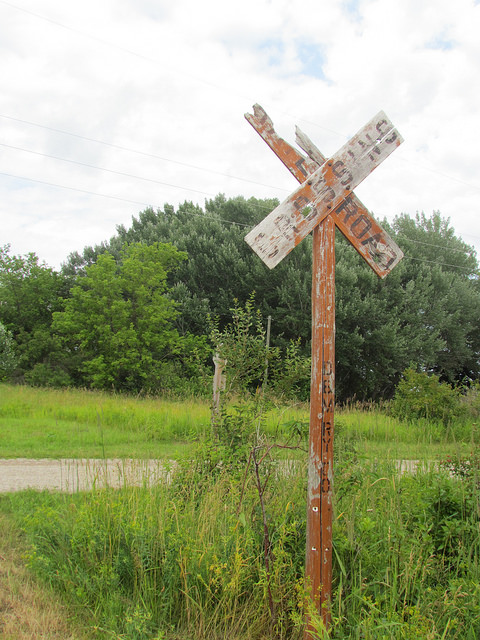
“Thinking that my wife and children would get safely away, I waited to see if nothing could be done to save the depot . . .The fire was then consuming dwellings on the outskirts of the village, and soon after the train had gone, I realized my task was hopeless . . .” George Cicero, the railway assistant agent in Metz, sent his last message: “I can send no more. This building is all afire.” He ran through the woods to the next town. His wife and three children were in the gondola.
Is it possible this was the fire my grandmother and family fled, on an earlier train? These thoughts and other questions set me to researching the event a few years back. Some of the accounts gave me nightmares. I dared to start a novel but didn’t dare myself to continue writing. I tucked the first pages away in a box.
When we were back in Michigan this past summer, a visit to Ocqueoc Falls took my husband and me through the town of Tower. We stopped for lunch in Onaway at the Wood Winds Restaurant and Pizzeria, which opened in 1958 as the first A&W® drive-in in northern Michigan. It’s the place with the life-size black bear in front and the elk antler door handle. One of the placemat’s many advertisements was for a business in nearby Millersburg, and I realized where we were. After soup and salad and splitting a slice of homemade chocolate pie, I begged to take a short side trip.
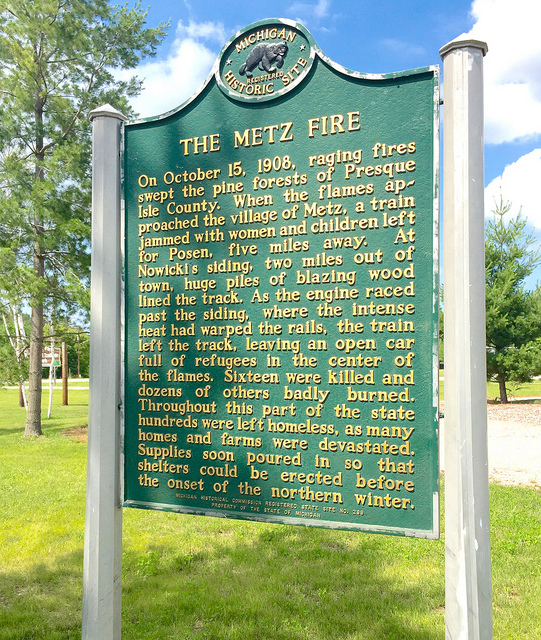
We turned off 68 onto Millersburg Road, and I imagined the inferno, saw flames billow across the land, heard their roar, and felt their heat. I imagined people running, ashes in their hair, maybe with clothes aflame. Was that pond there then? Did someone find safety in the middle of that body of water? Perhaps share it with their livestock and frightened wildlife?
“When the Village of Metz vanished into oblivion, all that remained were ashes, charred ruins and smoking rubble. The only building still standing was St. Dominic’s Catholic church, which actually was positioned just out of town to the southwest.” A house across the road from that church also survived, perhaps because bare ground left from harvested potatoes provided a safe barrier. (Sodder, p. 284)
As we approached the village, what there is of it, we passed the “new” St. Dominic’s on the left. The original church that survived the fire was moved some years back to serve as the church’s parish hall.
Just past the church sits the Metz Township Hall, and next to it is a small roadside park memorial with a playground and nature trail. Various markers describing the tragedy and its aftermath stand along a path. Weather-protected photos and articles line the interior walls of a pavilion. My husband and I spoke low, if at all, though nobody else was around—except for a few cars parked at the bar across Railroad Street. A couple of grills nestled next to the pavilion. I don’t think I could enjoy hot dogs at one of the picnic tables.
I sat in one of the swings and wondered if on this same spot a hundred-plus years ago, children may have shrieked not with laughter but with fear. I listened for the train whistle. I sensed an eerie aura when I looked up at the still-standing railroad track sign and then walked a ways down the rail-to-trail. I felt torn and disjointed between the now and the then on this beautiful sunny warm day.
A parishioner who was tending the church plantings at St. Dominic’s directed us to the old cemetery out of “town” about a mile where the original church used to stand. A home has since been built on that land, and we felt a bit like we were trespassing when we made our way out behind it to search out headstones that marked the resting places of fire victims. A couple of deer ran past.
The fire swallowed St. Peter’s Lutheran first. Three church members saved the organ, the Bible, and a crucifix and dumped them in a ditch. The crucifix and Bible remain in the church that was rebuilt on its original foundation. After we visited the old cemetery behind that church, I took note of all the bushes surrounding the building. They weren’t blooming, but I’m pretty sure they were lilacs. I remembered that Sodders wrote about how lilacs had been planted to mark the graves of victims of the Peshtigo Fire of 1871. (page 19-21) I thought about the hardiness of lilacs and of how fire increases the growth of wild ones, not only by scarifying the seed but also by opening the forest canopy to light. I wished these bushes were in bloom so I could take in the fragrance.
Said Pastor Ernest Thieme, “Sunday, I buried at one funeral, ten of the members of our church who died in the fire. It was a strange worship service, which I conducted with a loudly sobbing congregation alongside a church in ashes, conducted over open graves. I leaned against a lonely standing fence post, and wept, perhaps the first time since I was a child.”
The possibility that my grandmother may have experienced this fire connected me to the place and it seems to be part of my personal history, too. Perhaps it’s time to pull that novel out of the drawer.
Featured photo by Gabriel Caparó, Creative Commons, via Flickr. Post and photos by Sandra Heska King.
__________________________

“I require all our incoming poetry students—in the MFA I direct—to buy and read this book.”
—Jeanetta Calhoun Mish
- 50 States of Generosity: Iowa - April 7, 2025
- 50 States of Generosity: Montana - January 27, 2025
- 50 States of Generosity: Idaho - December 16, 2024
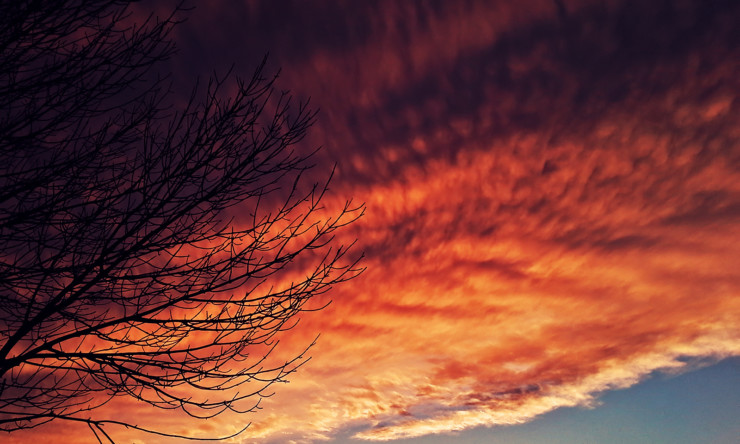
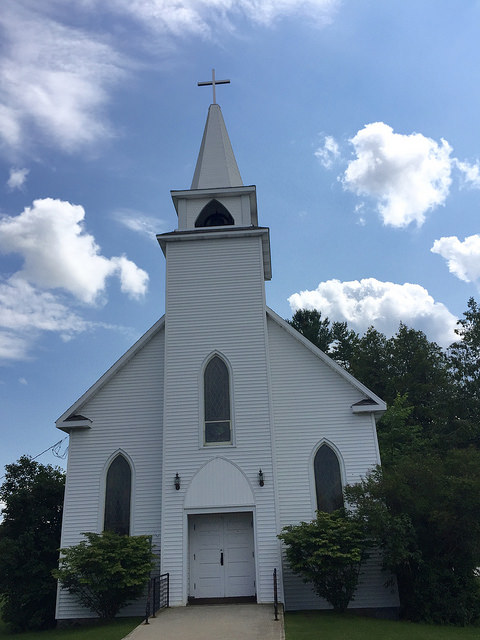
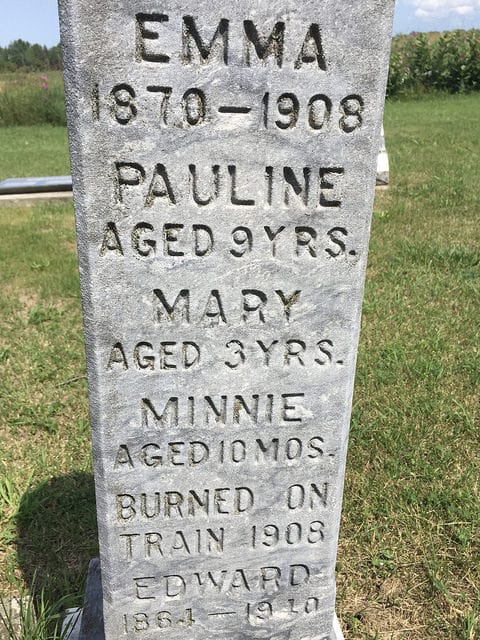
Glynn says
It was more than 100 years ago, but tragedies like the Metz fire leave their mark not only upon the physical landscape but also on the landscape of mind and memory. Good post, Sandra.
Sandra Heska King says
So true. And that this posted today while the fires rage in California is kind of eerie. While the physical landscape may recover, there are people there whose minds and memories are seared forever.
Thanks.
Lynn D. Morrissey says
Sandy this is powerful. What a horrific thing. And to think about your dear grandmother and to visit this place indeed was a hushed, holy experience. It speaks to me of the importance of understanding one’s roots and recording them in some way. Oh the power of the pen. I wish you well on that novel.
Wonderful, sobering post.
Love
Lynn
Sandra Heska King says
I do wish I’d “pumped” my grandmother more before she died 30 years ago. We lived out of state then when I might have appreciated the stories and might have even thought to write them down.
The many stories and news clippings I’ve read from this fire and others before and after are so tragic. What people did to try to save themselves–some successfully and some not. The losses they experienced. So sobering, yes.
Thanks for coming by, Lynn. I always appreciate “visiting” with you.
Bethany R. says
I didn’t know about this fire. Thank you for sharing a bit of the history of the people who went through it and for sharing about how your family may have connected to it.
Quite sobering to read the inscription on that grave marker. Tombstones and books can be such powerful ways to remember and honor the lives that came before our own—and may endure for generations beyond us.
Sandra Heska King says
I’m guessing not many outside Michigan know about it. And quite possibly not many *in* Michigan. The township has done a good job of remembering, though. Thanks for reading, Bethany.
Martha J Orlando says
Sandra, it is time to pull that novel out of the drawer. I have every confidence that you can raise the phoenix from the ashes. Just write, my friend, just write . . .
Blessings!
Sandra Heska King says
Maybe I will, Martha. Maybe I will. Thanks. 🙂
Katie says
Oh, Sandra –
I could not agree more with Lynn and Martha in their encouraging you to write that novel.
As I’ve watched the destruction caused by the fires in CA my heart has gone out to all those who have lost homes and more.
Your post has made the reality of such devastation that much more real in my mind.
As usual I’ve turned to Webster for words to process such loss. In doing so I learned there are 50+ compound words that begin with fire!
In an effort to commemorate some of the heroism taking place I offer these cinquains:
Death Dragon
red hot
tall flames leaping
devouring structures with
such rapidity, thoroughness,
power
Fire Warrior
fighting
they run forward
even toward danger
the combustion, conflagration
saving
Devastation
gone now
buildings once owned
lived and worked in, burned down
to the ground, scorched, torched, up in smoke
ashes
Inferno
total
cataclysmic
unimaginable
no extinguisher, nor hydrant
can save
My thoughts and prayers for all suffering from these fires.
Sandra Heska King says
Oh my goodness, Katie. These are powerful. Thank you for writing them.
Did you see this from the LA times? It reminded me again of the stories of those from the Metz fire (and others) who plunged into bodies of water (there are stories of sharing the water with frightened wild (normally dangerous) animals.
http://www.latimes.com/local/abcarian/la-me-abcarian-sonoma-fire-20171012-htmlstory.html
Katie says
Sandra,
Just, WOW. Thank you for sharing that link.
What a harrowing experience that must have been! Their will to survive was strong. Oh, the RELIEF those daughters had to have felt when they knew their parents had made it through.
Thank you for your comment on the cinquains:)
You’re more than welcome. Found it therapeutic.
Gratefully.
Katie
Carol Longenecker Hiestand says
Sandra, I am fascinated by history and of course, especially when it is around my own ancestors. I can get lost in the story – what a privilege to find yourself there to experience this. thanks for sharing.
Sandra Heska Ling says
It was indeed moving experience. Thanks so much for coming by, Carol.
Stacy says
My great-grandmother was one of the people in the gondola car (her mother and three sisters didn’t — they’re the ones listed on the gravestone photo in the article.
Sandra Heska King says
Oh, my goodness, Stacy!! That gives me chills. Thank you for sharing this. So your great-grandmother survived to tell the story? How on earth did she escape? Was she the oldest?
Are you from Michigan? Have you seen this stone in person?